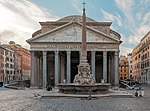Amphitheater of Caligula
The Amphitheater of Caligula (Latin : Amphitheatrum Caligulae) was an Roman amphitheater, built during the reign of the emperor Caligula and demolished only a few years after its construction. It was sited on the Campus Martius in Rome, probably near the Saepta Julia, since the inscription mentioning it was just to the north of the Saepta.Work was begun on the amphitheater between 37 and 41 by Caligula, who wished to give Rome a second stone amphitheater alongside that of Statilius Taurus. Still incomplete on his death, it was abandoned and demolished by Claudius. Around 46, Claudius repaired the Aqua Virgo, damaged by the construction of the amphitheater. His restoration was marked by an inscription on the Arch of Claudius, which formed part of the aqueduct and spanned the Via Lata; this includes the phrase "[…] AQUAE VIRGINIS DISTVRBATOS PER C(AIVM) CAESAREM" (of the Aqua Virgo, damaged by C[aius] Caesar).
Excerpt from the Wikipedia article Amphitheater of Caligula (License: CC BY-SA 3.0, Authors).Amphitheater of Caligula
Piazza Capranica, Rome Municipio Roma I
Geographical coordinates (GPS) Address Nearby Places Show on map
Geographical coordinates (GPS)
| Latitude | Longitude |
|---|---|
| N 41.8998 ° | E 12.4777 ° |
Address
Degli Effetti
Piazza Capranica
00186 Rome, Municipio Roma I
Lazio, Italy
Open on Google Maps










